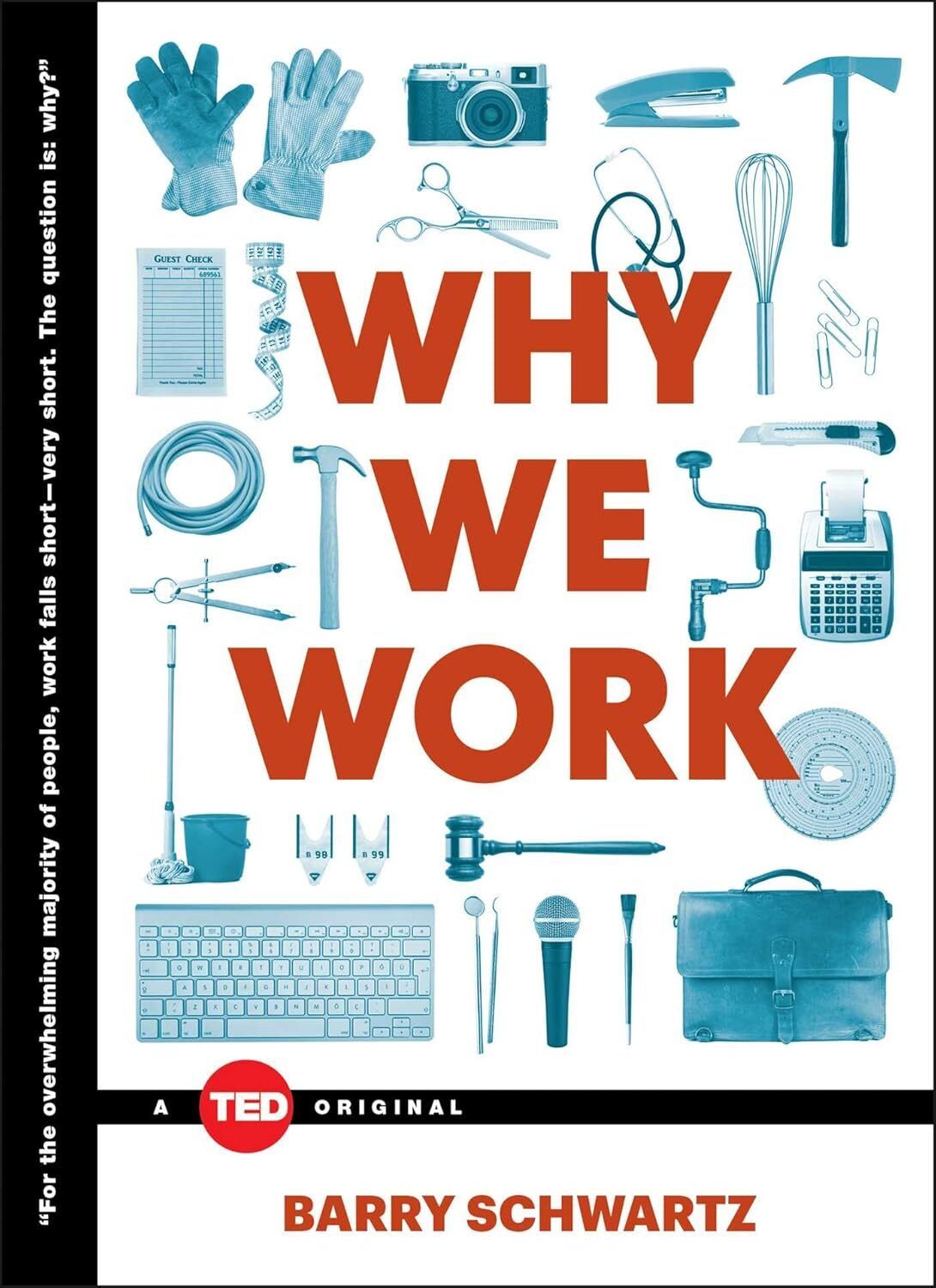- The Wealth Expedition
- Posts
- Changing the Expression of Human Nature
Changing the Expression of Human Nature
We as humans like to work. We may not realize it during the day-to-day activity, but we do! Designing good jobs is the wave of the future.

Our weekly newsletter features the following sections:
First time reading? Subscribe for weekly content here.
“Industrialization has been a spectacular human achievement. But as it has relieved material poverty, it has done so at the price of poverty of spirit.”
“Perhaps this was a necessary price to pay at earlier stages of economic development. But that is no longer the case. When it comes to the transformation of the human workplace, there is really no time like the present.”
-Why We Work by Barry Schwartz

NEWS
What Happened Last Week
Of the 13% of S&P 500 companies that have already reported earnings, 82% have surpassed the earlier estimates.
Both US Presidential candidates have espoused a plan for economic growth. VP Harris’ plan is more based on demand-side economics, and former President Trump’s plan is based on supply-side economics.
Stock markets are apolitical. There is very little evidence that one party is better for the financial markets than another. Regardless of the outcome this November, markets are likely to hold up nicely in the absence of a sudden shock event.
The S&P 500 is well above its 50-day and 200-day moving averages.
Investing has become popular again, and high expectations have pushed prices higher according to the AAII Investor Sentiment Survey and Fear and Greed Index.
How I See It
Markets are excited right now.
We’re approaching the end of an election year, and people are eager for a change of power. This is very common that the second half of an election year is positive due to the reducing uncertainty around the outcome.
The S&P 500 was up 15.14% by mid-year (June 28), and it’s up a total of 22.5% as of mid-Monday.
Is this too much too fast?
Market return numbers alone can’t tell us the answer to this. In fact, 23% is very close to the average market return in a bull market year. It’s those bear markets that bring the average back down to around 9%-10% over the long-run.
And markets don’t revert to their average just for the sake of it.
However, market corrections can happen even in the midst of the overall uptrend. Dropping 10%-20% quickly is not uncommon, and it accompanies a lot of bad news from the media. But corrections usually recover just as quickly as they start.
We have a lot of positive things happening: falling interest rates, a change of government leadership, the advent of AI and changes in energy usage.
Of course, the negatives involve mainly the geopolitical risk around the world.
Another slight risk remains if there is a clean sweep of one party across the House, Senate and President, which can create temporary uncertainty due to greater potential changes in regulation.
But while investors remain optimistic, this doesn’t appear to be unusual for late-stage bull markets. And bull markets can run on high optimism for years, achieving some of their greatest returns of the cycle.
While there is always risk being invested in stock markets, remember that this bull market is only two years old, and the odds appear to favor a continued bull run (with volatility) for at least the next several months if not years.

PARADIGM SHIFT
Changing the Expression of Human Nature
Can human nature be altered?
More specifically, can you change your own nature?
That is the question that is tackled by Barry Schwartz in the little book Why We Work.
He proposes that human nature, when offered a choice, prefers to work. We as humans want to do something important, that improves the lives of those around us, and that challenges us to become better versions of ourselves.
But here’s the problem.
In the name of economic efficiency, our workplaces have been more and more refined to a hyper niche division of labor. Instead of exercising the kind of autonomy and creativity that we once had on the farms or in the trades, we have sacrificed part of what makes us human in exchange for security in the form of a regular paycheck.
In the process, we’ve designed many workplaces where the only reason people show up every day is the paycheck. By and large, many are no longer inspired to work simply out of interest, care and passion for what they do. The workplace design has changed the expression of our human nature.
Here’s the incredible and excellent news: the world has largely been lifted out of abject poverty. But now we turn our eyes to the spirit. Have we gained the whole world and lost our souls?
A 2022 survey by UKG discovered that 46% of American workers would not want anyone they cared about to have to endure their own personal job, and 38% wouldn’t even wish it on their worst enemies.
Here’s the question.
Are you part of the almost 50% of Americans who can’t wait to leave their jobs?
I am in process of designing a course specifically aimed at helping individuals redesign their lives with the flexibility to choose. Choice will be put back into your hands. Everything from how you work to how you play.
In the meantime, consider this.
While we all have to earn money, we will end up making more in the long-run if we focus on these three things: 1) the purpose behind our work, 2) the integrity with which we do that work and 3) the experiential knowledge we can gain from that work.
The first two points will inspire us to go above and beyond, regardless of the presence or absence of financial incentives. And the third is a revolving door of opportunity to eventually apply our unique store of knowledge to our next role, eventually leading to our entrepreneurial endeavors!


FINANCIAL TOOL
Moving Averages
There are two types of market analysis: fundamental and technical.
Fundamental analysis focuses on actual value provided by a company. Technical analysis focuses on patterns of investor psychology that show up in the charts.
Fundamental analysis, though more difficult, has a much better track record than technical analysis in terms of long-term success.
But here’s one technical pattern which may hold some legitimacy.
Moving averages.
A moving average measures the average price point over a certain number of days. So over 100 days, maybe the average price of an asset was $200. Maybe tomorrow, the average has ticked up to $201. The 100 days are measured on a rolling basis.
Then we can chart the change in this 100-day average on a line chart. And we can determine if the current price is above or below this average.
Two commonly watched moving averages are the 50-day and the 200-day averages.
A 2022 study by the CFA Institute’s Research & Policy Center showed that, over the last six decades, there is actually a correlation between market prices being above the 50- or 200-day moving average and the likelihood that they will increase on that day.
For example, if the moving average is $200, but the price opens at $202, they found a higher chance that the price would continue to increase rather than decrease on that day. If it opened below the average, such as $198, then there was a higher chance the price would decrease rather than increase.
Does that mean it’s better to go to cash every time a moving average is crossed to the downside?
No.
But it does potentially provide a valuable signal which, in combination with fundamental analysis, could help us determine whether a bear market may be on the horizon. And that can allow us to prepare our risk accordingly.
You can view moving averages for free at Yahoo Finance. For the asset you wish you measure, on the Summary page, click “Advanced Chart.” You can then click “Indicators” and choose “Moving Average,” which you will be able to edit for number of days.

HERE’S HOW I CAN HELP
FUTURE RESOURCES ARE IN THE WORKS!
You will have access to in-depth digital courses in the very near future.
The first major course will reveal how to create a massive surplus monthly cash flow that perpetually increases through a combination of budgeting, increasing earning potential and investing.
We will be focused on comprehensive wealth which values not only money but also time and freedom.
Until then, I’d like to recommend this book called Why We Work. It is a short, easy read, proposing that there is a far better way to structure the workplace so that the paycheck ends up coming second in priority.
We have overused division of labor, complete with micromanagement, a hyper-focus on metrics, and too much dependence on financial incentives to get employees to do their jobs. And thus we are left with an array of soul-sucking, mind-numbing jobs.
Who wants to be just a cog in a machine?
The solution? This book offers a call to society to intentionally design jobs which inspire us, fulfill us, and fully utilize our capacity to create and apply our unique gifts to the service of humanity.
And I’ll add my two cents: if you can’t find a job like this, create one for yourself! It is possible, and I look forward to showing you how.
Why We Work by Barry Schwartz

This post contains affiliate links, which means I may earn a commission if you make a purchase through these links at no additional cost to you. Thank you for your support!

I’d love to hear from you. Let me know what you’d like to see in upcoming newsletters, articles, or a digital course at Contact Us - The Wealth Expedition.
